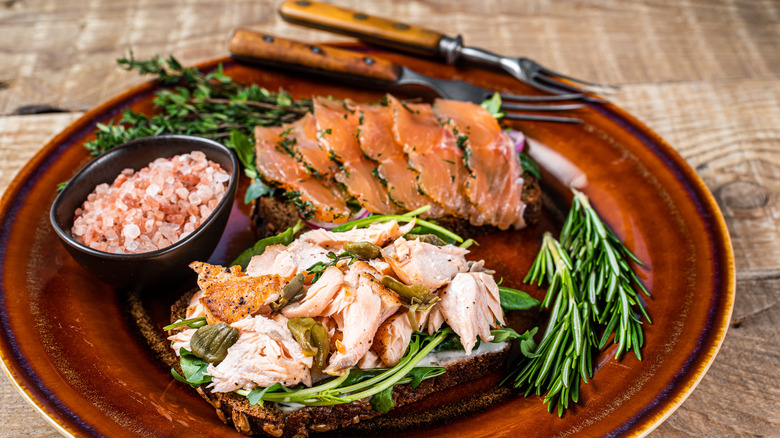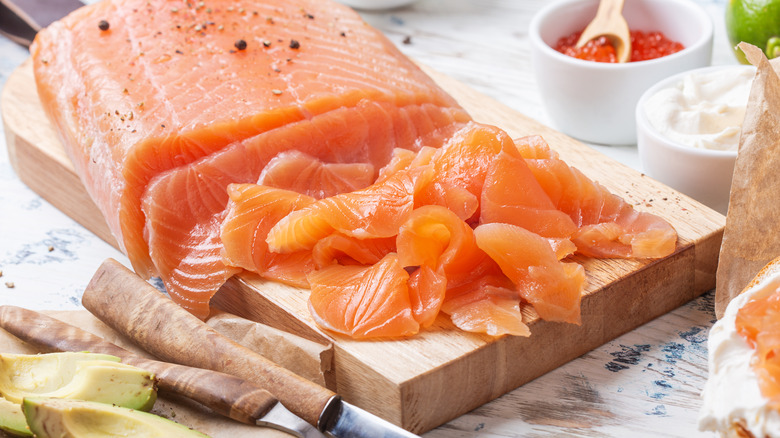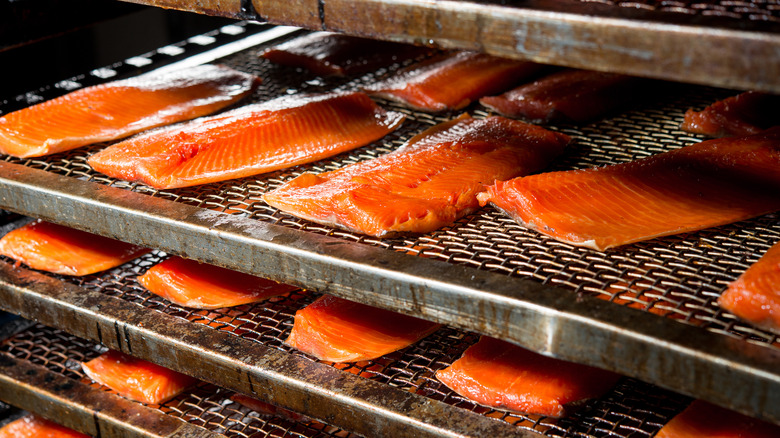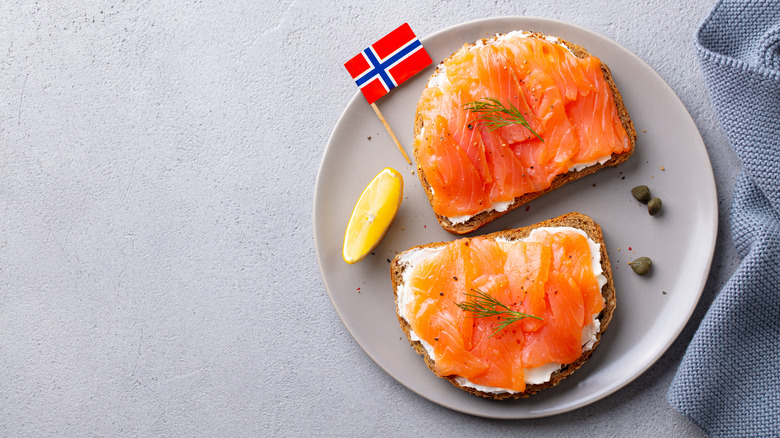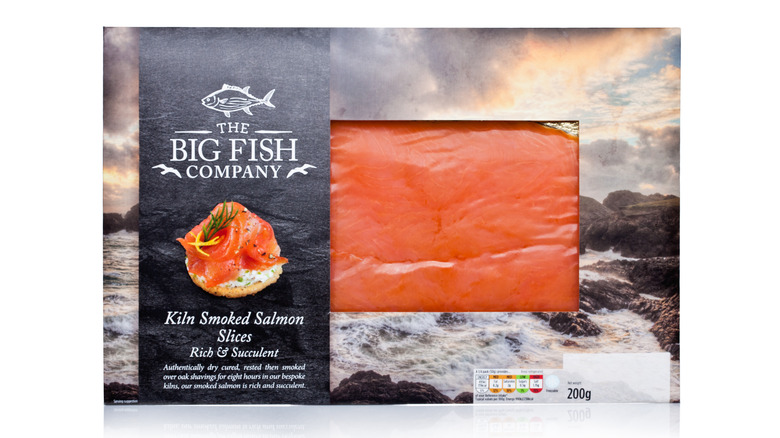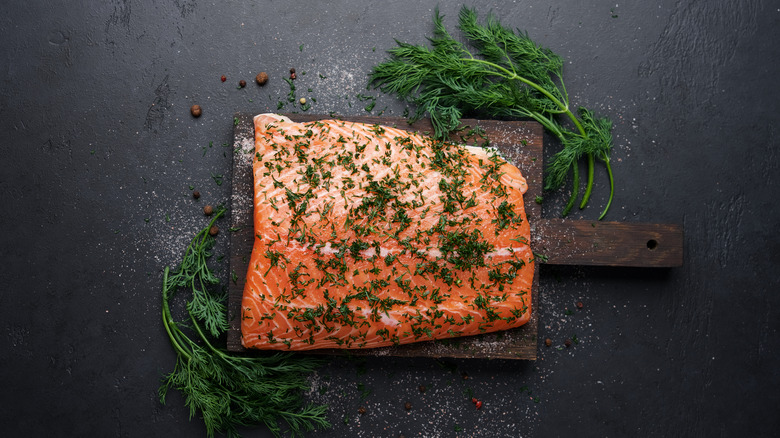The Real Difference Between Hot Smoked Salmon And Cold Smoked Salmon
Smoked salmon is one of those simple luxuries that can elevate any meal to star status. While it's certainly more expensive than fresh salmon, it doesn't quite have the same price tag as other indulgences from the sea, such as caviar, making it more approachable. Sometimes sold side by side, hot and cold smoked salmon look and taste significantly different.
Surprisingly, the two renditions are simply different versions of the same fish and process. Both are indeed smoked, but the similarities in the process end there. Bon Appétit explains that before cold smoking, the fish is dry-cured with salt, so the smoking process doesn't actually cook the fish. On the other hand, prior to hot smoking, the site describes salmon being lightly cured in a wet brine and cooked due to the higher heat in the smoking process.
Though they may seem like minor differences, the final outcomes of hot and cold smoked salmon have different textures, flavors, uses, and shelf-life.
What is cold smoked salmon?
Fine Cooking indicates that with cold smoked salmon, the smoking occurs between 75 and 85 degrees Fahrenheit, and doesn't actually have the effect of cooking the fish. In this case, the smoking process mostly imparts flavor, leaving the fish closer to its natural state. At such a low temperature, smoking can go on for hours and even a couple of days, according to My Foodbook.
Since no cooking occurs at these lower temperatures, the fish is first dry-cured in salt to bring out excess moisture (via City Fish Market). The curing process preserves the fish, slowly "cooking" it up to 24 hours, without using heat (via Fine Cooking). At this point, additional seasoning such as dill can be added to enhance the flavor profile. My Foodbook explains that as the moisture is drawn out, the fish essentially becomes more compact, making it easier for the smoke flavor to infuse throughout. Nevertheless, due to the cooler temperature, the smokiness is subtle, whereas the saltiness from the curing process is quite noticeable.
The final texture of cold smoked salmon is smooth, silky, and with a color closer to raw salmon. Since it's denser, the fish can be cut into thin, almost translucent slices and is generally sold pre-sliced and sealed (via My Foodbook).
What is hot smoked salmon?
First and foremost, salmon that will be hot smoked is placed in a wet brine in order to add some flavor, moisture, and salt to the fish, explains My Foodbook. Contrary to cold smoked salmon, the goal is to keep the fish moist since it will be smoked at high heat, considerably drying it out. After brining and before smoking, Solex Catsmo, an artisanal smokehouse, mentions that a glaze or rub might be added. They recommend flavors such as maple, teriyaki, and pepper, to match the stronger smokiness of the fish.
Temperatures are much higher, and Fine Cooking explains that hot smoked salmon is prepared from 120 to 180 degrees Fahrenheit, for six to 12 hours. At this heat, the salmon is being cooked during the smoking process and absorbs far more flavor than at lower heat. Hot smoking works well with a fattier fish such as salmon since it doesn't significantly dry out during the process, allowing smoke to permeate into the taste (via Quality Seafood Delivery).
The higher temperatures — and resulting effect of actually cooking the salmon — means that hot smoked salmon differs hugely in terms of texture. It approaches the look of cooked salmon and is best described as flaky. Due to the consistency, hot cooked salmon isn't sold sliced, rather packaged as a filet and vacuum sealed.
What dishes work best with each?
Since cold and hot smoked salmon vary so wildly in terms of their texture and flavor, they are often used in different dishes, though some overlap as well. The two varieties can both be eaten cold from the package, as they are packed with flavor from the smoking process and sometimes thanks to extra seasonings and rubs.
Cold smoked salmon comes pre-sliced and ready to eat. Sweet + Savory Blog recommends it for making canapés, as it pairs well with raw vegetables, crostinis, deviled eggs, blinis, and other bite-sized appetizers. It also tastes delicious with cream cheese and capers on a bagel for a filling breakfast. Cold smoked salmon is also a great addition to sushi and is often used on the exterior of a roll. Due to its silky, velvety consistency, it's ideal eaten cold to maintain the delicate texture.
Having already been cooked and exposed to high heat, hot smoked salmon is definitely the more versatile of the two. It can be heated and used in dishes that require additional cooking, such as quiche, pasta, omelets, and chowder, and it also blends well into creamy dips (via Solex Catsmo). At the same time, it can be eaten cold in a sandwich, salad, or wherever you want to add rich flavor.
Regional style preferences
Although both styles of smoked salmon can be found across the country, cold-smoked salmon is more common on the East Coast, whereas hot smoked versions are popular on the West Coast (via City Fish Market).
On the East Coast, cold smoked salmon stems from traditions in the Nordic countries (via Solex Catsmo). Epicurious explains that this style is often named the Gaspe Nova style, after Nova Scotia on Canada's east coast. The site indicates that nowadays, Nova is synonymous with cold smoked salmon from the Atlantic, regardless of its proximity to Nova Scotia. The Washington Post mentions other common Atlantic styles such as Irish, Scottish, and Norwegian.
Niki Russ Federman, fourth generation owner of the iconic Russ & Daughters in New York City, knows a thing or two about smoked salmon. She describes some popular styles to Eater including Gaspe Nova, Scottish, and Western salmon, in decreasing order of fattiness. The fat content affects moisture, firmness, and flavor of the final product.
Solex Catsmo notes that the popularity of hot smoked salmon on the West Coast reflects how people catch their own fish and improvise by smoking it on a barbecue. To trace the steps back in history, The New York Times recounts that hot smoked salmon was typical among the Upper Skagit tribe in Washington State's Cascade region. The article goes on to say that hot smoked salmon was also standard practice in Sweden, uniting the West and East Coast traditions.
How should you store smoked salmon?
Since production, ingredients, and packaging can vary significantly, it's always best to check the label on your specific product. If you don't anticipate eating your smoked salmon for many weeks, Still Tasty recommends freezing it for up to three months for best results, although it will still be safe past this duration. If it isn't vacuum sealed, make sure to properly seal it before freezing. When defrosting salmon, Still Tasty notes it's best to do so in the refrigerator and use it within three to four days. For texture and food safety, it is not advisable to refreeze defrosted fish (via Robust Kitchen).
Since cold smoked salmon is not actually cooked, it requires refrigeration. Fine Cooking indicates that it can be kept refrigerated for up to two weeks sealed. Some products might have longer "best before" dates so there may be some variation. Once the fish has been opened, wrap it tightly and aim to consume it within one week (via Banner Smoked Fish).
Hot smoked salmon on the other hand has been cooked during the smoking process, reducing the possibility of bacteria. Some vacuum-sealed packages may be kept at room temperature, such as SeaBear's product, which preserves the fish in its own juices. However for maximum freshness, hot smoked salmon also benefits from being refrigerated. Though it can last slightly longer when opened compared to cold smoked salmon, it's best to consume it within a week (via Can it go bad?).
How is cold smoked salmon similar to gravlax or lox?
Cold smoked salmon is very similar in appearance to other styles of cured fish, including gravlax and lox. The defining distinction is that neither gravlax nor lox are actually smoked. Lox is the Yiddish word for salmon, and Food & Wine explains that it is salt-cured salmon belly, typically found in Jewish cuisine. It's often interchanged for cold smoked salmon when found on a bagel with cream cheese, but lox has none of the smokiness of the former.
Gravlax is a Scandinavian dish that also entails curing salmon, however unlike the regular salt cure that is done prior to cold smoking salmon, the brine for gravlax is more complex. A standard gravlax brine uses salt, sugar, and dill, and can include unique extras such as juniper berries, vodka, aquavit, and horseradish for flavor (via Food & Wine).
So much salmon, so little time!
